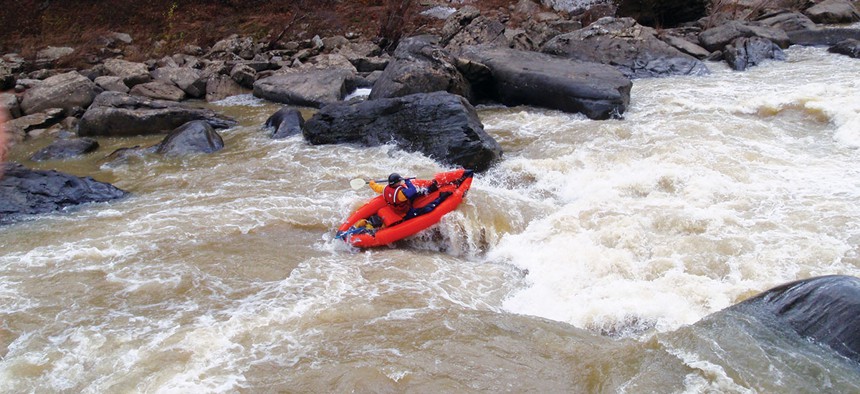
Ranger Matt Hudson runs the rapids on Big South Fork National River. Kemper Begley/National Park Service
Defying Ranger Danger
NPS’ Matt Hudson says he was just doing his job during a courageous nighttime rescue.
After Matt Hudson received the call that his services were needed to rescue a man stuck on a rock amid Class IV rapids, he and his team—Brett Painter and Thomas Hall—had an hour’s drive to think about all the risks and dangers awaiting them.
Hudson, a National Park Service ranger at Obed Wild and Scenic River in Tennessee, never got cold feet on the ride over to Big South Fork National River, where the individual was stranded. He was not sure he and his partners would be able to run the rapids in the dark (he received the call around 10 p.m.), but Hudson still took his inflatable kayak into the water while Painter and Hall took a raft.
“You have a waterproof headlamp but it doesn’t project very far,” Hudson says of navigating at night. “The thing that replaces sight is knowledge of the river.”
The rescuers eventually were able to pull the man to safety, give him shoes and dry clothing, and let him walk along the riverbank while Hudson kayaked in the water. After a short period, however, the bank became unwalkable and Hudson gave up the kayak for the victim and swam next to him.
Hudson refuses to take too much credit.
“The swimming thing may sound cooler than it actually is,” he says. “I was basically swimming in calmer water.” Hudson notes, however, the victim almost certainly would have drowned if he had tried to swim on his own before the rangers arrived, and also was at risk for hypothermia.
Despite his modesty, Hudson, as well as Painter, Hall and 12 additional Park Service employees were recognized in May at the 70th Honor Award Convocation in Washington.
While he was indeed honored, Hudson still plays it cool.
“It’s just what rangers do,” he says. “We go out and we paddle and we rescue people.”
- Eric Katz
Sacked, Suspended, and What Comes Next
The tiny Merit Systems Protection Board is a major player in the debate over whether it should be easier to fire federal employees. But a lot of people, including lawmakers, still don’t totally understand its role in federal personnel law.
MSPB comes in at the end of the process for workers who’ve been fired or subjected to some other adverse personnel action. Two things have to happen before the MSPB gets involved: The agency acts, and an employee appeals that action. “There is no preemptive role that we take,” says Susan Tsui
Grundmann, MSPB chair.
Grundmann and her agency are pushing back against some misconceptions about MSPB’s role, including whether employees who are appealing their case are receiving a paycheck. “When we get the case, the employee is off the rolls,” says Grundmann, dispelling the notion that agencies don’t take expeditious action in misconduct cases because they are waiting for MSPB’s decision. “They’ve been fired, they’ve been suspended, whatever. They don’t receive any [back] pay unless they prevail with us.”
MSPB published a report in May on the history and case law surrounding due process, how it applies to the federal workforce, and a list of fallacies related to suspending or sacking an employee. The agency was clear that firing a government worker may be difficult, but it’s not impossible.
- Kellie Lunney
Safety in Numbers
When hurricane season bears down on communities across the country, few people think about how federal operations will persevere—unless they don’t. The same goes for a multitude of natural and human events like wildfires, floods, power outages, protests and security breaches. This is where federal executive boards come in. Located in 28 cities, FEBs work to improve communication and coordination among agencies across the country. Aside from workforce and community support, a big part of their mission is emergency preparedness and safety:
774k Federal civilians served in FEB areas in fiscal 2014
128 Operating status reports issued for severe weather, fires, power outages and security breaches
74 Emergency planning workshops hosted by FEBs, serving 4,400 participants
32 Continuity of operations exercises serving 2,200 participants
Solar Ready Vets
A bright-burning future is the lure for anyone who navigates a career transition. But perhaps none view their prospects with more intensity than warfighters returning to civilian ambitions.
In April, President Obama announced the Solar Ready Vets program, a joint Energy and Defense department effort to give service members the skills needed in the growing alternative energy industry.
It’s a merger of Energy’s training program called Sunshot and the Pentagon’s Skillbridge, a collection of internships and apprenticeships that allows service members to train up to six months before they muster out.
Now operating at 10 military bases, the program will train vets to size and install solar panels and connect electricity to local grids—they may also become sales people and inspectors. Courses are taught by companies, unions and academics.
The program “makes good business sense,” says Frank DiGiovanni, the Pentagon’s director of force readiness and training. “Since service members continue to receive military pay and benefits while participating, the training provider does not pay the service member to participate,” and the employer gets a “test run” with the veteran.
Chris Cortez, a Microsoft vice president, says, “These young military people bring skills, work ethic, and this is the kind of employee the industry needs.”
With solar firms now hiring at 10 times the rate of other industries, Obama set a goal of training 75,000 workers for the renewable energy industry by 2020.
- Charles S. Clark
Govlish as a Second Language
“Govlish is the language of Govland. Native Govlanders write and speak in it. Demystify it, and government is accessible to everyone.”
That is the mission statement on the website Govlish, which aggregates and analyzes more than 100,000 terms to help people decode the federal bureaucracy. Founder Robert Mander conducted
a study of public sentiment toward government speak. A scant 2 percent of respondents called the terms “precise and logical,” 61 percent called the language “insider jargon,” 12 percent said it was “mumbo jumbo,” and none said it was “easy to learn.”
Surprisingly, these ratings are from people in the know. Most survey respondents were government employees or contractors. To test your fluency, you can take a quiz on Govlish.
- Susan Fourney
What’s an SME?
A. Systems Maritime Engineer
B. Subject Matter Expert
C. Stupid Manager Error
What does LORACS stand for?
A. Logistics Office Request for Application to Contractor Status
B. Little or Reduced Access to Common Sense
C. Liaison Officer for Recognized and Authorized Classification Societies
How do you say “OSDBU” (Office of Small and Disadvantaged Business Utilization)?
A. It sounds like oh-SAD-bee-you
B. You cannot say OSDBU
C. It’s said as OZ-dih-boo
(Answers: B, C, C)
NEXT STORY: Around Government






